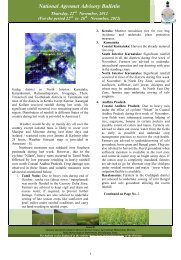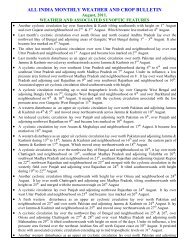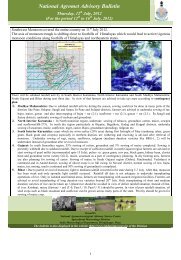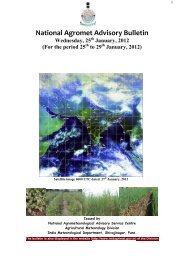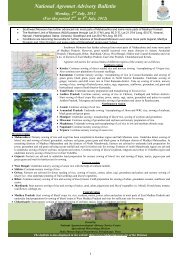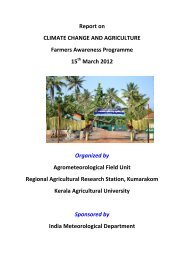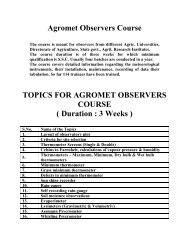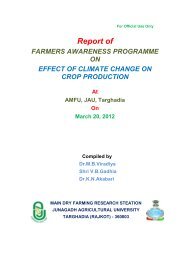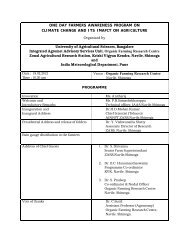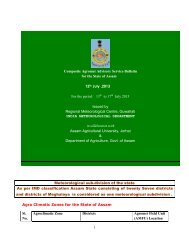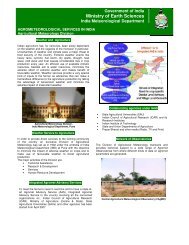Ranichauri - Agricultural Meteorology Division
Ranichauri - Agricultural Meteorology Division
Ranichauri - Agricultural Meteorology Division
Create successful ePaper yourself
Turn your PDF publications into a flip-book with our unique Google optimized e-Paper software.
local weather, effects of climate change as evident from Gangotri Glacier continuously receding overthe years, on apple orchards i.e. new apple orchards being raised in higher hills from mid hills tomaintain the quality as well as quantity observed from the research conducted viz. an increase of 1 0 Ctemperature in the region will compel to shift apple orchards by about 300m altitude and advised thefarmers to follow the suggestions provided through the Agromet Advisory Services in whichadvisories being imparted through biweekly bulletins and the website: imd.gov.in;cropweatheroutlook.ernet.in for coming week for different agricultural operations to be carried out aswell as contingency measures according to the prevailing weather conditions, knowledge onoccurrence of pest and diseases and their preventive measures were given in the bulletins & websitesbased on medium range weather forecast received from India Meteorological Department,Meteorological Centre, Dehradun and Pune and same was broadcasted regularly on Tuesday &Friday in Krishi Jagat Programme from All India Radio, Nazibabad.Dr. Anuradha Dutta, Professor Extension (Home Science) explained the climate change hasbecome a threat to the entire ecosystem since the past few decades. However it is the farmingcommunity that is the most severely effected. The condition in the Hill region is even worse as thefarming system here is basically rainfed. Farming in the hills is mainly done by women, therefore itis they who are worst affected by climate change. Procurement of fuel, fodder and water too is thewomen’s responsibility, in addition to care of livestock. Therefore it is very important that womenhave to be sensitized about climate change and prepared to adopt the alternate crop contingencyplans whenever they face the eventuality like drought, break in SW monsoon resulting the midseason drought and improved technologies in order to mitigate the impact of global warming and theresultant changes. Women of the hills are by nature very shy and reticent. Organizing them intogroups helps to generate confidence and enthusiasm in them regarding the changes in weather fromyear to year.In the past few years the women farmers of the hill region have been encouraged to form selfhelp groups as a step to empower them. However these groups need regular strengthening andcapacity building to keep pace with the fast changing needs of agriculture due to climate change. Inorder to keep the self help groups proactive the members should ensure that:1. All members are aware about the rules and regulations of the SHG2. All rules are strictly adhered to.3. There is complete transparency in the financial dealings of the group4. The SHG should hold regular meetings5. The SHG should have regular contact with the sponsoring agency.
d`f"kokfudh ds vUrZxr pkjk o`{k iztkfr;ks dks d`f"kHkwfe ij d`f"kQlyksa ds lkFk Hkh jksfirfd;k tk ldrk gS ioZrh; {ks=ks esa ikS/k jksfir djus ds fy, 3X3 ehVj dk vUrjky laLrqrfd;k x;k gSA vR;kf/kd o`f} nj okyh iztkfr;ks es 1 X 1 ehVj ds vUrj ij jksfir djdsizFke o"kZ esa gh vf/kd pkjk rFkk bZ/ku ds fy, ydM+h izkIr dh tk ldrh gSA ioZrh; {ks=ks esikS/kksa ds jksi.k ds fy, izk;% vPNh Hkwfe esa 30 X 30 X 30 lss0eh0 vkdkj ds xM
5. To reduce ground water pollution6. To improve the quality of ground water7. To reduce the soil erosion8. To supplement domestic water requirement during summer, drought etc.The major advantages of rain water harvesting are1. Provides self-sufficiency to your water supply2. Reduces the cost for pumping of ground water3. Provides high quality water, soft and low in minerals4. Reduces soil erosion in hilly and urban areas5. The rooftop rain water harvesting is less expensive6. Rooftop rain water harvesting systems are easy to construct, operate and maintainDr. Chandra Dev talked about the different crop rotations with the cost involved in packageof practices as well as agricultural operations to be carried out during the crop growing period i.e.kharif & rabi seasons in perspectives of climate change with improved practices along with theirbenefits accrued over the traditional practices in vogue as well as cost benefit ratio of different croprotations (cereals, oil seeds, pulses and vegetable crops) being followed in the region and hesuggested about growing of short duration and more profitable vegetable crops viz. capsicum, radish,veg. pea, cabbage, french bean etc. which can be grown easily keeping in view the weatherconditions prevailing in the region since this region are most suitable for off season vegetable cropswhich fetches high remuneration to the farmers.Dr. B K Khanduri Assistant Professor (Social Science) & Programme Officer (NSS) gavethe description in brief about the different programme organized by National Service Scheme,College of Forestry & Hill Agriculture, Hill Campus, <strong>Ranichauri</strong> in villages for the awareness of thefarmers as well as general public viz. Plantation Work, Awareness on National Literacy Mission,Environment Day, Children Education, Water Harvesting and Conservation etc with theirimportance. He also talked about the importance of vegetables in human dietary system and advisedto consume more vegetable in diet to improve their health as well as their economic wellnessobtained through selling of produce in the markets located nearby and in plains during off season.Dr Sachan delivered a lecture on soil testing management in relation to climate change. Hetold about the soil testing, its objective and its necessity in present day scenario and the method ofsoil sampling. The farmers were told that 15 cm depth hole is dug in the soil, through khurpi or kutlaand all the soil is taken out from that hole. This practice is done at 4 to 5 places in a one nali area.
The soil is then collected and mixed and 500 g soil is filled in a clean polythene bag. A tag withfarmers name and place and all relevant details is attached with the polythene bag and sent to thelaboratory. For the soil sampling of orchards/ horticultural plants sampling will be done at thefollowing depth 0-30 cm, 31-60 cm and 61-100 cm. The soil from the following depths will becollected separately in separate polythene, and the tags will be attached accordingly. The soilsampling for a depth of 1 m will be done through soil auger or phawda.The farmers were also told about the importance of organic matter in soil fertilitymanagement. The farmers were told about the techniques for making farm yard manure and vermincomposting.For vermin-composting the farmers were told the entire methodology related to the sizeof vermipit, how to cover the vermipit, the species of earthworms to be used, the bedding material,intercultural operations and the qualities of good vermicompost. How this vermicompost will be usedby the farmers was also demonstrated. The farmers were also told about the importance of organicmatter in soil water conservation. The farmers also realized through their experience that in thosefields the soil moisture holding capacity was high where the soil organic matter content was high.The farmers also realized that due to changing climate, the precipitation has decreased and with thatthe soil moisture content has also decreased. Therefore soil carbon/ organic matter buildup will helpin soil moisture conservation. The farmers were also told to decrease the slope of their land as thatthe rainfall falling on the soil, enters the soil and the runoff is minimized. This will help the farmersin checking the soil erosion and there by increasing the soil fertility.Mr. Shambhoo Prasad, Technical officer – Integrated Agromet Advisory Services(IMD)talked in detail with the farmers about importance of the weather forecast, types of weather forecast,Integrated Agromet Advisory Bulletin & its importance to farmers with respect to crop production,use of quality seeds, different agricultural practices and plant protection measures needed to adoptfor successful farming in hill zone of Uttarakhand. He informed that farming is reducing every yearbut point of satisfaction that production is also remains same. He emphasized that productionconstraint affecting small millets cultivation should be solved and farmers should get reasonableprice for their produce. He also presented the list of improved varieties with specific featuresrecommended for Uttarakhand hills in different small millet crops. He informed that in finger milletPES 400, VL-315, VL-324, PRM-1 and PRM-2 are the varieties recommended for the Uttarakhandhills. In Barnyard millet VL-172, VL-207 and PRJ-1 are varieties for hills of Uttarakhand. Heinformed the area above than 1000 m amsl, PRJ-1 is the best variety as has been proved by theperformance of variety at the farmer’s field. He also informed about the improved varieties of othermillets viz. PS-4 and PRK-1 in foxtail millet and PRC-1 of prosomillets. The best time for growingthe finger millet and barnyard millet under hill conditions are found suitable as under:
Integrated Agromet Advisory Services – India Meteorological DepartmentNew Delhi“Farmers Awareness Programme on Climate Change”Questionnaire for FarmersQ.1 Which is the most important weather parameter influence agriculture production in youropinion?Ans. (a) Rainfall – 62% (b) Temperature – 21% (c) Sunshine – 12% (d) Wind Speed - Nil(e) Relative Humidity - 5%Q.2 Which months are the hottest and coldest in your region, if known, give the values?Ans. (a) April - Nil (b) May – 92% (c) June – 8% (d) December – 4% (e) January – 96%Q.3 When (month/week) do you receive highest rainfall? Indicate the average annual rainfall of yourregionAns. July & August Months – 96%. Average Annual Rainfall –35%Q.4 Have you seen any time the instruments that measure rainfall and temperature? Can you namethem?Ans. Seen - 8%. Named – 5%.Q.5 Did you notice any increase/decrease in the following weather parameters over the years?Ans.Sl. No. Weather parameters Increase Decrease No Changea Rainfall - Yes -b Summer temperature Yes - -c Winter temperature - Yes -d Cyclones - - -e Heavy rainfall events Yes - -f Dust storms - - -g Frost Yes - -h Pests/diseases Yes - -Q.6 Farm decisions are taken throughAns. (a) Traditional Knowledge/experience - 42% (b) Block Level Agriculture Officer – 7%(c) Newspapers - 12% (d) Television – 29%(e) Radio – 35% (f) KVK – 16%(g) Agro Advisory Services - 32% (h) Above all –19%Q.7 Have you changed any crops based on climate variability in the recent years?Ans. (a) Yes - Nil (b) No – 100%Q.8 If yes, reasons for it and what crops have been changed. N/AAns. Reasons(a) Non-profitable(b) Not yielding due to change in weather(c) Labour problems(d) Crop loss due to damages by extreme weather events
(e) Less Irrigation availability (f) Crop yield are not stable(g) Increased attack by damages of pests/diseasesCropsEarlier cropsChanged cropsQ.9 Which are the following weather parameters and their combinations that influences pests anddiseases?Ans. (a) Cloudy weather – 22% (b) High humidity – 38% (c) High Temperature - Nil(d) Low temperature - Nil (e) Rainfall - 40% (f) Wind speed - NilQ.10 Are you following pesticide application in controlling pests/diseases or any ecofriendly/IPMpractices?Ans. Yes – 35% No – 65%Q.11 Do you feel that in spite of more pesticides are being used to control pests/diseases, yet the pestdamage did not reduce?Ans. (a) Yes - 56% (b) No – 44%Q.12 Do you feel that more application of pesticides/ insecticides harm the environment?Ans. (a) Yes - 88% (b) No – 12%Q.13 If yes, what action do you suggest to reduce their applicationsAns. (a) Use of scientific methods - 6% (b) Apply only when it is essential – 12%(c) Use of bio- pesticides (like neem concentrate) – 36%(d) Release of natural enemies (bio-control agents) – 46%Q.14 Do you listen and follow the advisories given by the Agromet Unit?Ans. (a) Yes – 55% (b) No – 45%Q.15 Do you think that weather based farm advisories are useful in improving the yields?Ans. (a) Yes – 82% (b) No – 18%Q.16 Approximately how much benefit did you realize by following the weather based agrometadvisories provided by the respective Agrometeorologist?Ans. Profit Rs 1000.00 to Rs 1500.00 depending on the crops.Q.17 Have you any time incurred losses by following advisories?Ans. (a) Yes – 22% (b) No – 78%Q.18 If yes, what types of advisories that put you to lossAns. Through application of pesticides, fertilizer and agricultural operationsQ.19 Don’t you feel that conservation of natural resources like water, soil, biodiversity, mangrovesetc., play a dominant role in curtailing the impacts of climate change?
Ans. Yes – 56% No – 44%Q.20 If so, do you take a pledge to conserve all the natural resources like saving inirrigation/minimum tillage, reduction pollution levels in water and air and save for futuregenerations?Ans. (a) Yes – 98% (b) No – 2%Q.21 Can you name at least one measure that you would like to implement to save the earth fromglobal warming such as reduction the use of free power, less application of fertilize andpesticides use, more organic manure?Ans. Use of more organic manure and plantation in the region.Q.22 Do you think that One-day Program is useful in learning new things about weather?Ans. (a) Yes – 62% (b) No – 38%In the last, Meeting ended with thanks given by Dr. Chandra DevR. K. SinghNodal Officer – IAAS (IMD) Project



